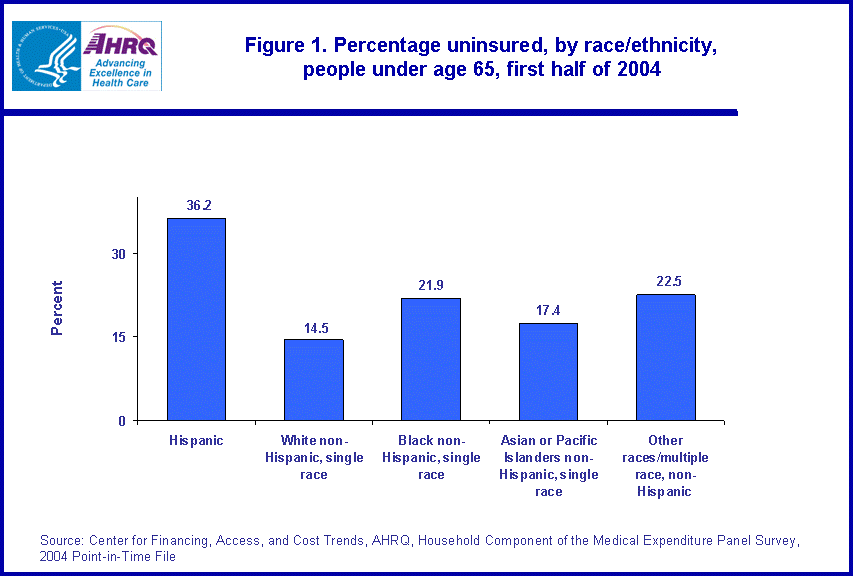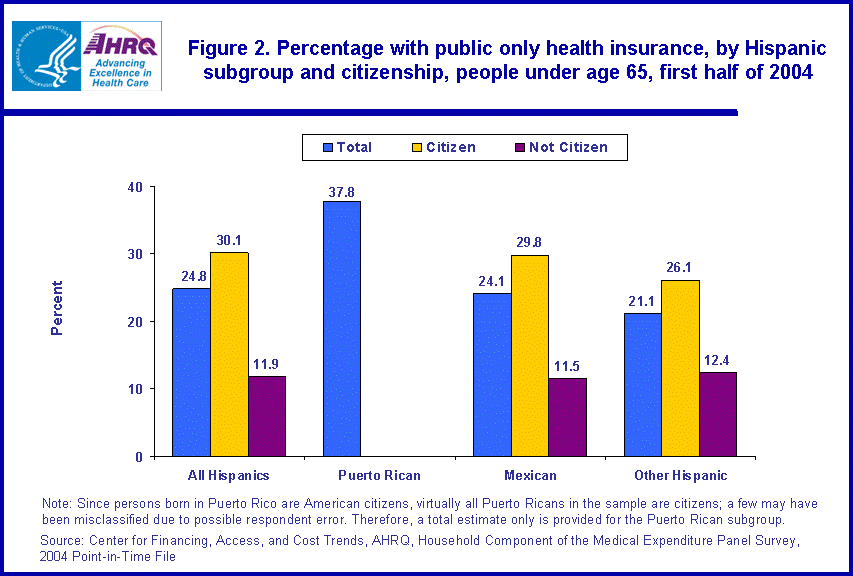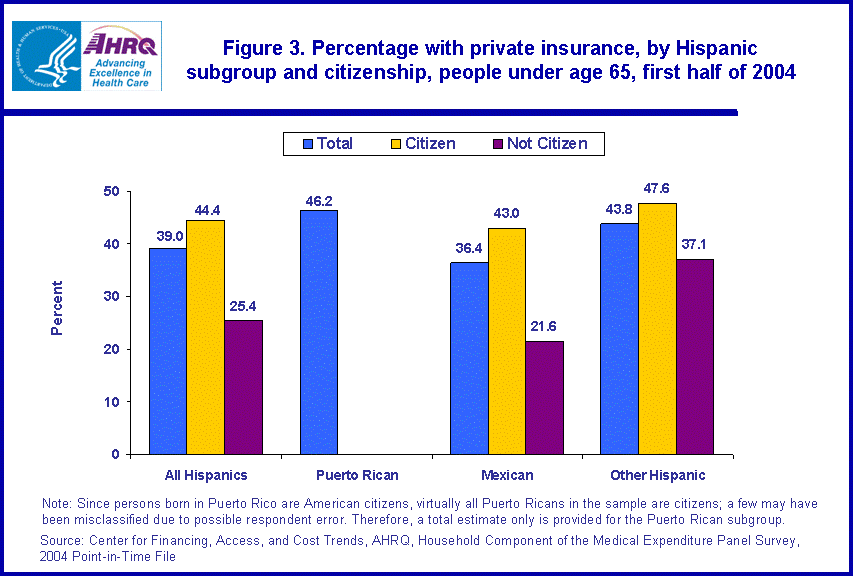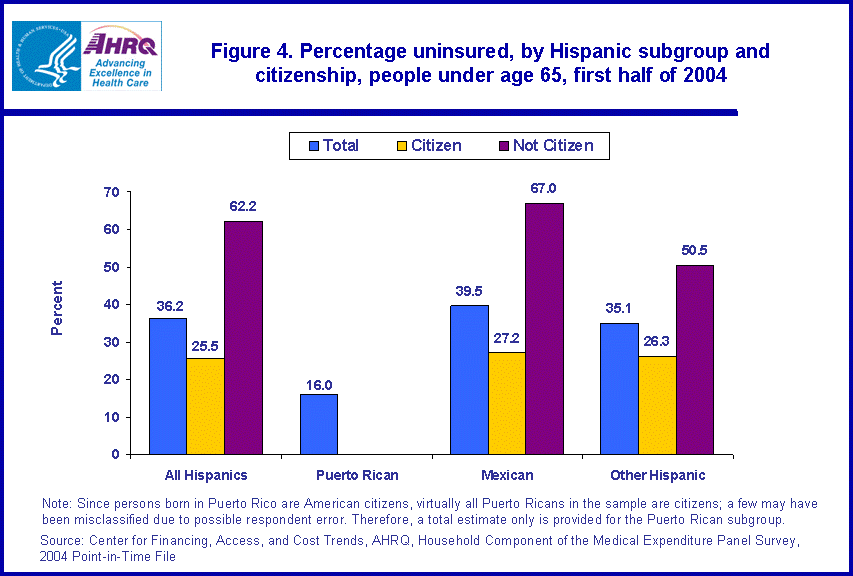
|
|
Font Size:
|
||||
|
|
|
|
||||
STATISTICAL BRIEF #143:
Health Insurance Status of Hispanic Subpopulations in 2004: Estimates for the U.S. Civilian Noninstitutionalized Population under Age 65
Highlights
- In 2004, Hispanics had the highest rate of being uninsured of all racial/ethnic groups. More than one in three Hispanics (36.2 percent) were uninsured throughout the first half of the year.
- Puerto Ricans were the most likely of all Hispanic subgroups to be enrolled in public only health insurance and the least likely to be uninsured. In 2004, 37.8 percent of Puerto Ricans had public only health insurance as their only source of coverage, and 16.0 percent were uninsured.
- Mexicans (36.4 percent) were less likely to have private coverage than other Hispanic subgroups (43.8 percent).
- Hispanics who were not U.S. citizens were more than twice as likely to be uninsured as those who were citizens.
Introduction
Government statistics on health insurance often present estimates for the Hispanic population as a whole. For many years, these estimates have revealed that the Hispanic population has the highest rate of being uninsured of all racial/ethnic subgroups in the United States.
Using data from the Household Component of the Medical Expenditure Panel Survey (MEPS-HC), this Statistical Brief presents health insurance estimates for the Hispanic population by subgroups and U.S. citizenship status. An examination of these estimates reveals dramatic disparities in insurance coverage within the Hispanic population due to differences in eligibility for public programs and access to private coverage.
All differences between estimates discussed in the text are statistically significant at the 0.05 level unless otherwise noted.
Findings
Hispanics had the highest rate of being uninsured of all racial/ ethnic groups. In 2004, 36.2 percent of Hispanics were uninsured throughout the first half of 2004 compared with 14.5 percent for non-Hispanic whites, 21.9 percent for non-Hispanic blacks, 17.4 percent for non-Hispanic Asian and Pacific Islanders, and 22.5 percent for non-Hispanic other races/multiple race individuals (figure 1).
Puerto Ricans had the highest rate of public only coverage (37.8 percent) among the Hispanic subpopulations (figure 2). This is not surprising, given that persons born in Puerto Rico are American citizens and thus do not have to become legal residents to gain access to public only health insurance.* However, even those Mexicans (29.8 percent) and other Hispanics (26.1 percent) who were citizens were less likely to have public only coverage than Puerto Ricans. Noncitizen Mexicans and other Hispanics had even lower rates of public only coverage than citizens (11.5 and 12.4 percent, respectively).
Mexicans (36.4 percent) had the lowest rate of private coverage among the Hispanic subgroups (figure 3). This was mainly due to the large proportion of Mexicans who were not U.S. citizens and who had very low rates of private coverage (21.6 percent). Hispanics who were citizens in all subgroups had similar rates of private coverage (between 43.0 and 47.6 percent). Other Hispanics who were noncitizens also had lower rates of private coverage than their citizen counterparts (37.1 percent versus 47.6 percent, respectively).
Puerto Ricans' high rate of public only coverage contributed to their having the lowest rate of uninsurance among all Hispanic subgroups. Only 16.0 percent of Puerto Ricans were uninsured compared with 39.5 and 35.1 percent, respectively, of Mexicans and other Hispanics (figure 4). Mexicans and other Hispanics who were not U.S. citizens were more than twice as likely to be uninsured as those who were citizens. Two-thirds of noncitizen Mexicans were uninsured (67.0 percent) compared with 27.2 percent of citizens. Noncitizen individuals in the other Hispanic subgroup were also much more likely to be uninsured than their citizen counterparts (50.5 percent versus 26.3 percent, respectively) (figure 4).
Data Source
The estimates shown in this Statistical Brief are drawn from analyses conducted by the MEPS staff from the 2004 point-in-time public use file: HC-075. U.S.-born status was derived by linkage of the MEPS sample to the 2003 National Health Interview Survey sponsored by the National Center for Health Statistics.
Definitions
Uninsured
Individuals classified as uninsured throughout the first half of the year did not have public only or private health insurance coverage during the period from January of the survey year through the time of their first interview in that year. Interviews were typically conducted from February to June. Individuals covered only by noncomprehensive State-specific programs (e.g., Maryland Kidney Disease Program) or private single-service plans (e.g., coverage for dental or vision care only, coverage for accidents or specific diseases) were considered to be uninsured.
Public only coverage
Individuals were considered to have public only health insurance coverage if they were not covered by private insurance and they were covered by Medicare, Medicaid, TRICARE, or other public only hospital and physician coverage.
Private coverage
Private health insurance coverage was defined as nonpublic insurance that provided coverage for hospital and physician care (including Medigap coverage).
Race/ethnicity
Classification by race/ethnicity was based on information reported for each family member. Respondents were asked if each family member's race was best described as American Indian, Alaska Native, Asian or Pacific Islander, black, white, or other. They also were asked if each family member's main national origin or ancestry was Puerto Rican; Cuban; Mexican, Mexicano, Mexican American, or Chicano; other Latin American; or other Spanish. All persons whose main national origin or ancestry was reported in one of these Hispanic groups, regardless of racial background, were classified as Hispanic. Since the Hispanic grouping can include black Hispanic, white Hispanic, Asian and Pacific Islanders Hispanic, and other Hispanic, the race categories of black, white, Asian and Pacific Islanders, and other do not include Hispanic. MEPS respondents who reported other single or multiple races and were non-Hispanic were included in the other category. For this analysis, the following classification by race and ethnicity was used: Hispanic (of any race), non-Hispanic blacks, non-Hispanic whites, non-Hispanic Asian and Pacific Islanders, non-Hispanic others, Puerto Ricans, Mexicans, and other Hispanic.
Note: The MEPS sample does not include Puerto Rico, but rather Puerto Ricans living in the contiguous United States.
Citizenship status
Citizenship status was imputed for approximately 15 percent of the sample.
About MEPS-HC
MEPS-HC is a nationally representative longitudinal survey that collects detailed information on health care utilization and expenditures, health insurance, and health status, as well as a wide variety of social, demographic, and economic characteristics for the civilian noninstitutionalized population. It is cosponsored by the Agency for Healthcare Research and Quality and the National Center for Health Statistics.
For more information about MEPS, call the MEPS information coordinator at AHRQ (301-427-1656) or visit the MEPS Web site at http://www.meps.ahrq.gov/
References
For a detailed description of the MEPS survey design, sample design, and methods used to minimize sources of nonsampling error, see the following publications:
Cohen, J. Design and Methods of the Medical Expenditure Panel Survey Household Component. MEPS Methodology Report No. 1. AHCPR Pub. No. 97-0026. Rockville, Md.: Agency for Health Care Policy and Research, 1997.
Cohen, S. Sample Design of the 1996 Medical Expenditure Panel Survey Household Component. MEPS Methodology Report No. 2. AHCPR Pub. No. 97-0027. Rockville, Md.: Agency for Health Care Policy and Research, 1997.
Cohen, S. Design Strategies and Innovations in the Medical Expenditure Panel Survey. Medical Care, July 2003: 41(7) Supplement: III-5-III-12.
Suggested Citation
Rhoades, J. A. and Vistnes, J. P. Health Insurance Status of Hispanic Subpopulations in 2004: Estimates for the U.S. Civilian Noninstitutionalized Population under Age 65. Statistical Brief #143. September 2006. Agency for Healthcare Research and Quality, Rockville, MD. http://www.meps.ahrq.gov/mepsweb/data_files/publications/st143/stat143.shtml
AHRQ welcomes questions and comments from readers of this publication who are interested in obtaining more information about access, cost, use, financing, and quality of health care in the United States. We also invite you to tell us how you are using this Statistical Brief and other MEPS data and tools and to share suggestions on how MEPS products might be enhanced to further meet your needs. Please e-mail us at mepspd@ahrq.gov or send a letter to the address below:
Steven B. Cohen, PhD, Director
Center for Financing, Access, and Cost Trends
Agency for Healthcare Research and Quality
540 Gaither Road
Rockville, MD 20850
Footnotes
*Vitullo, M. and Taylor, A. Latino Adults' Health Insurance Coverage: An Examination of Mexican and Puerto Rican Subgroup Differences. Journal of Health Care for the Poor and Underserved. 2002, 13(4), 504-525.
 |
||||||||||||||||||||||||||||||
|
||||||||||||||||||||||||||||||
|
|
||||||||||||||||||||||||||||||
 |
||||||||||||||||||||||||||||||
|
||||||||||||||||||||||||||||||
|
|
||||||||||||||||||||||||||||||
 |
||||||||||||||||||||||||||||||
|
||||||||||||||||||||||||||||||
|
|
||||||||||||||||||||||||||||||
 |
||||||||||||||||||||||||||||||
|
||||||||||||||||||||||||||||||
|
|
||||||||||||||||||||||||||||||


